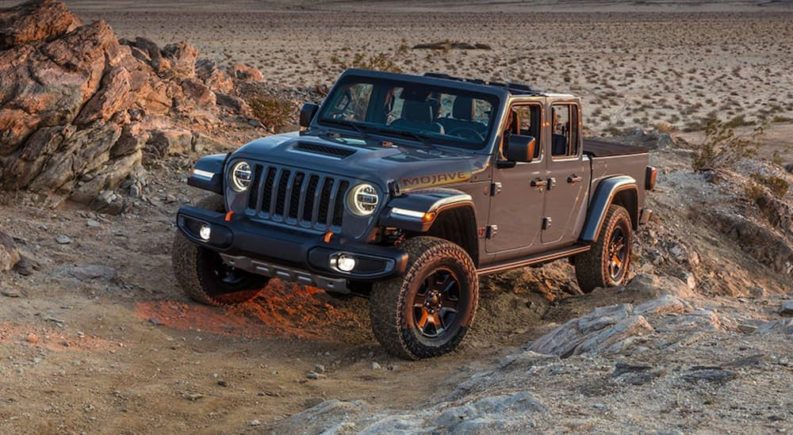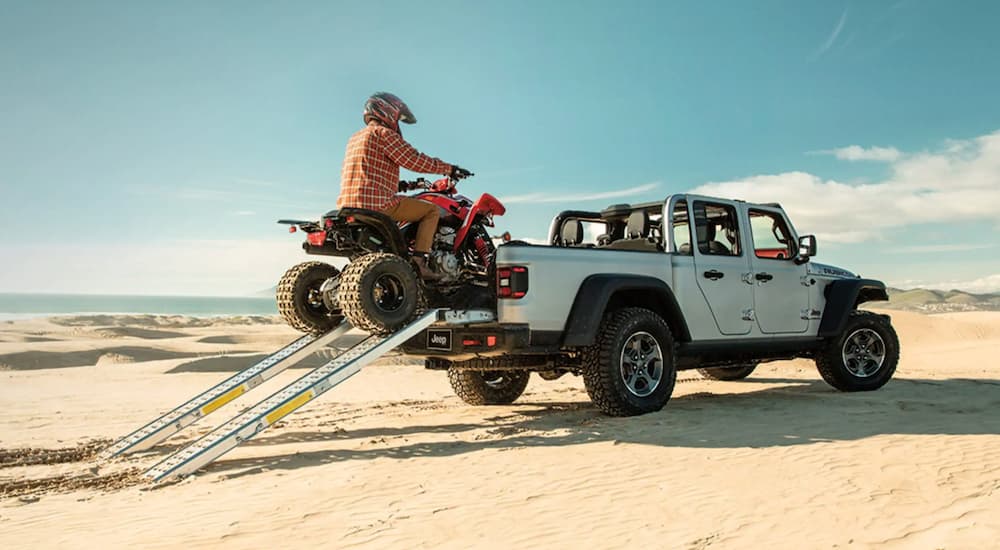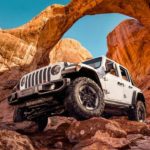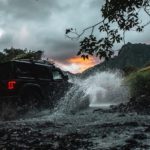If you’re thinking about setting up your dream Overlanding rig, start scanning the horizon for a Jeep Gladiator for sale. Jeep has a knack for making adventure-ready vehicles, and there’s none better suited for Overlanding than the Gladiator. This 4×4 pickup has off-roading capability straight off the lot, plus more room for activities than the Wrangler. Starting with an appropriate vehicle is key for successful Overlanding; it can save money on modifications and repairs down the line. The Gladiator makes it relatively simple to head out on an adventure, needing just a few upgrades to get it ready.
#1 – Wheels and Tires
Depending on the trim level, the Gladiator comes standard with all-season, all-terrain, or mud-terrain tires on 17-inch, 18-inch, or 20-inch wheels. You want a good amount of sidewall on your tire to allow some flex while driving on bumpy terrain, so 17-inch or 18-inch wheels paired with 33-inch to 35-inch tires are usually ideal. All-season tires are what come on the majority of Gladiator models, and they’re built to handle smoothly and efficiently on roads. But the attributes that make them handle well on the street are exactly what make them not so great at handling unpaved surfaces.
All-terrain tires work better for off-roading because they have deeper treads and thicker sidewalls, which grant the tire more grip and flexibility. Mud-terrain tires have an even blockier tread with more crevasses for loose earth to cake into, lessening your chance of losing traction. The right tire will depend on your specific needs: what’s the landscape like? What time of year is it? How far from civilization are we going? All-terrain or mud-terrain tires may do the trick, but different adventures may also call for snow or sand tires. Whatever tire your trip requires, be sure to bring a spare.
#2 – Suspension and Lift Kit
The Gladiator has a stock setup that provides 10 inches of ground clearance and allows for 30 inches of water fording. It’s also durable enough to handle a bump or two, and for a lot of people, that suspension may suit their Overlanding needs just fine. Certain trims even come standard with features like a disconnecting sway bar and locking differentials, both of which increase handling off-road. However, if the stock stuff doesn’t cut it for your needs, or you just want to modify your truck for the heck of it (this is a Jeep we’re talking about), a good place to start is giving the vehicle tougher shocks designed for off-roading conditions. Another popular modification is adding an inch or two of lift. More ground clearance means more effective crawling, fording, and climbing.
#3 – Living Space
Sleeping in a car isn’t comfy, even if you have seats that recline all the way back. That’s where setting up an Overlanding rig gets more involved than getting a vehicle ready for off-roading. Not only does the truck need to safely get you from one untrodden path to the next, but it also needs to be your home away from home. While it is an option to simply pack a tent with you and pitch it on the ground, a lot of Overlanders prefer to keep their vehicle in the equation. Thanks to its boxy cabin and pickup bed, the Gladiator can support tents on its roof or built into its bed. Other things to consider when converting your Gladiator into a tiny home:
Heat: Chances are, your adventures may take you somewhere frosty. If this is the case, adding a heater to your rig may be the difference between a night full of rest and a night full of shivering in your sleeping bag.
Water: Like most aftermarket gadgets and doodads, the options for keeping hydrated on the road are endless. Water tanks can be secured inside or outside the vehicle and come with a whole array of spouts, nozzles, and hoses.
#4 – Off-Road Lighting
The Gladiator’s stock headlights may not cut it when you’re miles away from a street lamp. Fortunately, there are plenty of choices when it comes to aftermarket lighting, making it possible to add some extra brightness practically anywhere on a Gladiator. Flood beams, spotlights, and lightbars can all come in handy for extra visibility while camping or off-roading. If you do add more lights, consider upgrading your batteries so you can power them with the engine off.
#5 – Communication
Being able to communicate without access to cell towers or Wi-Fi is a crucial part of staying safe off the road. To that end, there are several different kinds of radios that can be installed in the Gladiator with relative ease. The radio with the fewest barriers to entry is the Citizen Band or CB radio. Its range is somewhat limited, spanning a few miles at most, depending on the terrain, but CB radios tend to be inexpensive, and you don’t need a license to use them. Depending on your preference, they can be dash-mounted with an antenna installed on the vehicle or a portable handheld device. If the CB radio doesn’t cut it, the Ham radio gets far more range due to operating on more frequencies and having power capped at 1,500 W instead of 4 W. The downside? Operating a Ham radio requires a license from the Federal Communications Commission. Yes, there will be a test.
#6 – Navigation
If you were born after 1985, chances are your sense of direction has been seriously hindered by the accessibility of GPS in our mobile devices. Even if you have a good sense of cardinal directions, getting lost in the wilderness can spell serious trouble, so investing in a good navigation system is a safety precaution you probably don’t want to skip out on. There are plenty of different options to choose from, but most work by using a database of downloadable trail maps and satellite imaging to help drivers navigate without service. This may not be a modification, per se, but the GPS probably should be mounted somewhere secure and visible.
Home, Sweet Gladiator
When it comes to Overlanding, starting with a good foundation is crucial––we’re talking about building a home of sorts, after all. The better the foundation, the less money and time needs to go into modifying it and the more time and money you can spend on adventuring. The Gladiator is a particularly great choice here because it can drive straight off the showroom floor and into the wilderness. But no matter how good the foundation is, you can always do more to tweak your vehicle to better fit your needs.
When modifying becomes necessary, it helps to have a wide range of options for your various parts, rigs, and kits. Jeep has a fervent fan base obsessed with all things aftermarket, so there’s no limit to what can be done with a stock Gladiator. This community shows that there’s something to be said for modifying a car and making it your own. It has the potential to take your run-of-the-mill truck and transform it into a hobby that leads you to new places. If you’re interested in trying out Overlanding, then the Gladiator is a great place to start.





